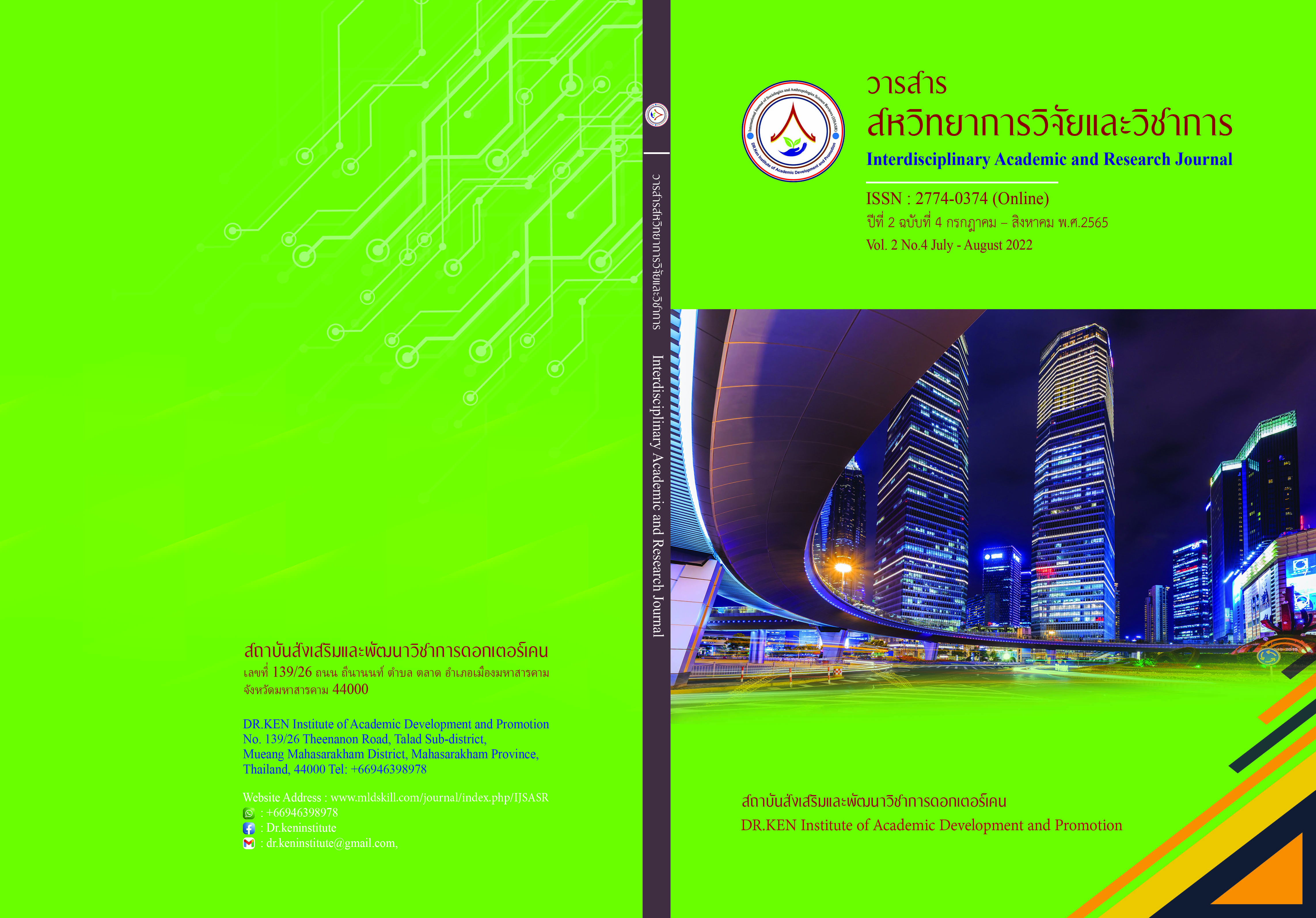Developing Collaborative Learning Activities with Jigsaw Techniques in the Economics, Secondary 1 Students
DOI:
https://doi.org/10.14456/iarj.2022.58Keywords:
Cooperative Learning Activities by Jigsaw Technique;, Learning Achievement; , SatisfactionAbstract
Innovative teaching and learning management thus contribute to higher student achievement. Teachers, therefore, adopt teaching and learning management by using a cooperative learning activity model using the jigsaw technique which has 5 steps in teaching to fit the context of school students so that students have Innovative new forms of learning that are more interesting, it is considered a thought process that is important to children, enabling them to create their ideas and create their imaginations. Therefore, this research is objective; (1) To develop collaborative learning activities with jigsaw techniques on the economics of Secondary 1 Students. (2) To study the index of effectiveness in cooperative learning with the economic jigsaw technique of Secondary 1 Students. (3) To compare the learning achievement of the first-year students who studied with the jigsaw cooperative learning management technique before and after school. And 4) to study the satisfaction of Grade 1 students towards the jigsaw technique of cooperative learning activities. The sample group in this research consisted of 7 Secondary 1 Students at Nong Kong Kindergarten School. Research tools (1) Plans for cooperative learning activities, jigsaw techniques, 10 plans, (2) A multiple-choice, four-choice, 30-item achievement test, and (3) a satisfaction questionnaire of 15 items. The statistics used in the data analysis were percentage, mean, standard deviation, and hypothesis test statistic with t-test (dependent). The results of the research showed that; (1) participatory learning activities using jigsaw techniques The results of the assessment of the appropriateness of the learning management plan. The average suitability assessment result was 4.49 at a high level of suitability. at a very reasonable level. (2) The effectiveness index of the jigsaw cooperative learning activities was 0.6694, indicating that the students had learning progress of 66.94 percent. (3) The students had a learning achievement. after school is higher than before with statistical significance at the.05. And (4) the students were satisfied with the jigsaw cooperative learning activities. Overall, it was at a high level (Mean= 4.49, S.D. = 0.62).
References
กนิษฐา จีถม. (2550). การใช้กิจกรรมต่อชิ้นส่วนเพื่อส่งเสริมความเข้าใจในการอ่าน การพูดภาษาอังกฤษ และ ทักษะทางสังคมของนักเรียนระดับก้าวหน้า. วิทยานิพนธ์ศึกษาศาสตรมหาบัณฑิต บัณฑิตวิทยาลัย มหาวิทยาลัยเชียงใหม่.
กระทรวงศึกษาธิการ. (2551). หลักสูตรแกนกลางการศึกษาขั้นพื้นฐานพุทธศักราช 2551. กรุงเทพฯ: กระทรงศึกษาธิการ
กระทรวงศึกษาธิการ. (2553). หลักสูตรแกนกลางการศึกษาขั้นพื้นฐาน พุทธศักราช 2551. พิมพ์ครั้งที่ 3 กรุงเทพฯ : โรงพิมพ์ชุมนุม สหกรณ์การเกษตรแห่งประเทศไทย จำกัด.
บุญชม ศรีสะอาด. (2556). วิธีการทางสถิติสำหรับการวิจัย เล่ม 1. พิมพ์ครั้งที่ 5, กรุงเทพฯ: สุวีริยาสาส์น.
ปจิตรา สมหมาย, ประภาศ ปานเจี๊ยงและนงนภัสส์ มากชูชิต. (2562). ผลการจัดการเรียนรู้แบบร่วมมือด้วยเทคนิคจิ๊กซอว์ (JIGSAW) ร่วมกับผังกราฟิกที่มีต่อผลสัมฤทธิ์ทางการเรียนวิชาประวัติศาสตร์ เรื่อง ภูมิภาคโลกของนักเรียนชั้นมัธยมศึกษาปีที่ 3 โรงเรียนขนาดใหญ่ สังกัดสำนักงานเขตพื้นที่การศึกษามัธยมศึกษา เขต 16. การประชุมหาดใหญ่วิชาการระดับชาติและนานาชาติครั้งที่ 11: มหาวิทยาลัยหาดใหญ่.
ประภัสสร ปรีเอี่ยม. (2561). บุพปัจจัยการพัฒนานักเรียนที่มีความต้องกการพิเศษโดยใช้เทคนิคการเสริมต่อ การเรียนรู้จากการปฏิบัติเพื่อเพิ่มศักยภาพในการปฏิบัติงานของครูในชั้นเรียนรวม. วารสารมหาวิทยาลัยราชภัฏมหาสารคาม, 12 (3), 271 – 280.
พุทธชาด วูโอริ. (2561). การพัฒนาการจัดการเรียนรู้แบบร่วมมือด้วยเทคนิคจิ๊กซอว์ร่วมกับการทบทวนหลังการปฏิบัติงานเพื่อส่งเสริมทักษะทางสังคม ของนักศึกษาคณะครุศาสตร์ มหาวิทยาลัยราชภัฏสุราษฎร์ธานี. วารสารราชภัฏสุราษฎร์ธานี. 6 (2), 173-192.
โรงเรียนอนุบาลหนองกอง. (2563). รายงานผลการดำเนินงานโรงเรียนอนุบาลหนองกอง ประจำปี 2563. อุดรธานี : โรงเรียนอนุบาลหนองกอง.
ศิรินภา น้อยสว่าง. (2562). การพัฒนากิจกรรมการเรียนรู้แบบร่วมมือ โดยใช้เทคนิคจิ๊กซอว์ เรื่อง วันสำคัญทางพระพุทธศาสนา สำหรับนักเรียนชั้นมัธยมศึกษาปีที่ 4. วิทยานิพนธ์หลักสูตรครุศาสตรมหาบัณฑิต: มหาวิทยาลัยราชภัฏมหาสารคาม.
สิทธิศักดิ์ จุลศิริพงษ์. (2550). การสอนสังคมศึกษาในโรงเรียนมัธยมศึกษา. นครราชสีมา: มหาวิทยาลัยราชภัฏนครราชสีมา.
สุพัตรา ทองคำ. (2559). การเปรียบเทียบผลสัมฤทธิ์ทางการเรียน เรื่องเวลากับประวัติศาสตร์ โดยใช้รูปแบบการเรียนรู้แบบร่วมมือเทคนิคจิ๊กซอว์กับการเรียนรู้แบบปกติ. โรงเรียนสาธิต: มหาวิทยาลัยราชภัฏสวนสุนันทา.
อรัญ ซุยกระเดื่อง. (2557). การวิจัยทางการศึกษา. มหาสารคาม : ตักสิลาการพิมพ์.
Munkham, S. (2007). Strategies of learning a creative thinking. 4th edition, Bangkok: Parbpim Printing.
Downloads
Published
How to Cite
Issue
Section
License
Copyright (c) 2022 ศิริลักษณ์ สุระขันธ์, ประภัสสร ปรีเอี่ยม, ประสพสุข ฤทธิเดช

This work is licensed under a Creative Commons Attribution-NonCommercial-NoDerivatives 4.0 International License.
Copyright on any article in the Interdisciplinary Academic and Research Journal is retained by the author(s) under the under the Creative Commons Attribution-NonCommercial-NoDerivatives 4.0 International License. Permission to use text, content, images, etc. of publication. Any user to read, download, copy, distribute, print, search, or link to the full texts of articles, crawl them for indexing, pass them as data to software, or use them for any other lawful purpose. But do not use it for commercial use or with the intent to benefit any business.
















.png)


